

UMass Phil 110: Introduction to Logic. Introduction to Symbolic Logic: Lecture 2. Math: Intro. to Symbolic Logic. Date: 06/27/2002 at 20:23:31 From: Carrie Henry Subject: Symbolic logic My question isn't exactly how to do a specific problem; it is to ask you if logic is a type of thing where either you get it or you don't.
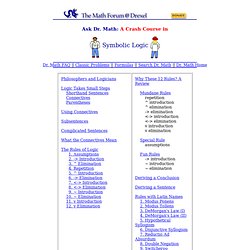
I recently had to drop symbolic logic because I just couldn't get it! Especially when we started doing derivations with rules of replacement like modus pollens. Derivations for SD+ are the most confusing, but I can't even get SD. "Symbolic Logic" Michael's Education: Lesson3- interference. LESSON 3 d Inference is a process by which a conclusion is drawn from a valid sequence and relationship of premises.
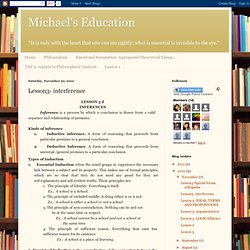
Kinds of inference 1. Inductive inference. A form of reasoning that proceeds from particular premises to a general conclusion. 2. Logic Lessons. Logic Chapter Two. Logic Chapter TwoNext Chapter Remember, there is no homework.
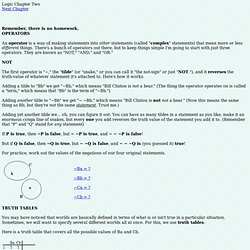
OPERATORS An operator is a way of making statements into other statements (called "complex" statements) that mean more or less different things. There's a bunch of operators out there, but to keep things simple I'm going to start with just three operators. Logic & Proof. Introduction Just as we did with sentential logic, we're going to begin our study of predicate logic with a look at its SYNTAX.

As you may have noticed, sentential logic doesn't concern itself with anything that goes on inside its atomic formulae—which we usually interpret as corresponding to English sentences (hence the name sentential logic)—only with the logical relationships between sentences or formulae. In predicate logic we not only consider these same logical relationships between sentences, we also begin to look inside their atomic components.
Given this change in perspective, we need to add some additional concepts to our syntactic stores. We do this not only by looking at the formal syntax for predicate logic, but also by analysing the logical structure of English sentences in a more refined way and reflecting , that structure through to translate English sentences into formulae in the language of predicate logic and vice versa. Goals for this Chapter: EXAMPLE: John laughed. Truth Tables - SEMANTIC QUBE modal logic predicate logic. Truth functions are generated on truth tables.
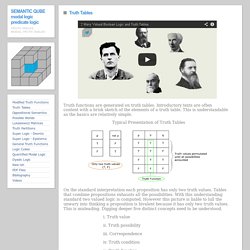
Introductory texts are often content with a brisk sketch of the elements of a truth table. This is understandable as the basics are relatively simple. Typical Presentation of Truth Tables On the standard interpretation each proposition has only two truth values. Tables that combine propositions exhausts all the possibilities. I. We already introduced the truth values {T, F} which mean True and False. Principles of Predicate Calculus. First-order predicate calculus or first-order logic is a theory in Symbolic logic that formalizes quantified statements such as "there exists an object with the property that...

" or "for all objects, the following is true... ". First-order logic is distinguished from higher-order logic in that it does not allow statements such as "for every property, the following is true... " or "there exists a set of objects such that... ". Nevertheless, first-order logic is strong enough to formalize all of Set theory and thereby virtually all of Mathematics.
It is the classical logical theory underlying mathematics. Like any logical theory, first-order calculus consists of a specification of how to construct syntactically correct statements (the well-formed formulas) a set of axioms, each axiom being a well-formed formula itself a set of inference rules which allow to prove theorems from axioms or earlier proven theorems. The well-formed formulas contain ∀ x ∃ y : y > x ∃ y ∀ x : y > x Formally: Links for "Symbolic Logic"
Logic Powerpoints. Presentation "INTRODUCTION TO SYMBOLIC LOGIC Propositional Logic & Truth Functional Analysis." The Fallacy-a-Day PodcastThe Fallacy-a-Day Podcast. Argument from ignorance (Argumentum Ad Ignorantiam, or appeal to ignorance) is an informal fallacy that asserts that a proposition is true because it has not been proven false (or vice versa).

It is a type of false dichotomy because it ignores the alternative possibility that there is insufficient information to prove that the proposition is either true or false. The fallacy exploits the facts that: (a) True things can never be disproven, and (b) False things can never be proven. Appeals to ignorance claim that the converse of these facts is also true; namely that: (c) If a proposition has not been disproven, then it must be considered true, and (d) If a proposition has not been proven, then it must be considered false. Notice that (c) and (d) are examples of the fallacy of affirming the consequent of (a) and (b), respectively.
Example: Psychic phenomena do not exist because no-one has proved that they exist. Sets. Lecture 7. Lecture 7 Categorical Propositions and Immediate Inferences Categorical Propositions: Any proposition which relates two or more classes of objects All categorical propositions are divided into two distinct logical parts which are associated with the terms which make up the object classes being compared I.
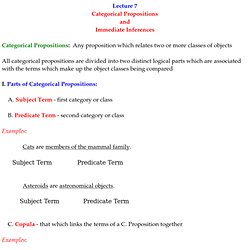
A. B. Examples: Cats are members of the mammal family. Asteroids are astronomical objects. Subject Term Predicate Term Cats are members of the mammal class. Copula Asteroids are astronomical objects. D. 1. CATEGORICAL SYLLOGISM. Logical Deductions - Syllogisms. Logic. Syllogisms by Ryan Mammarella on Prezi.